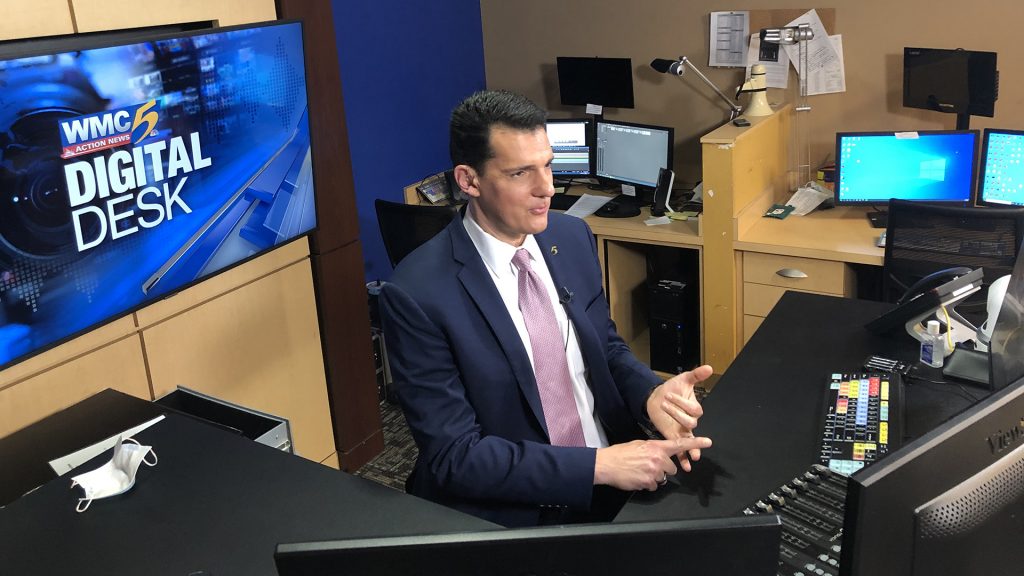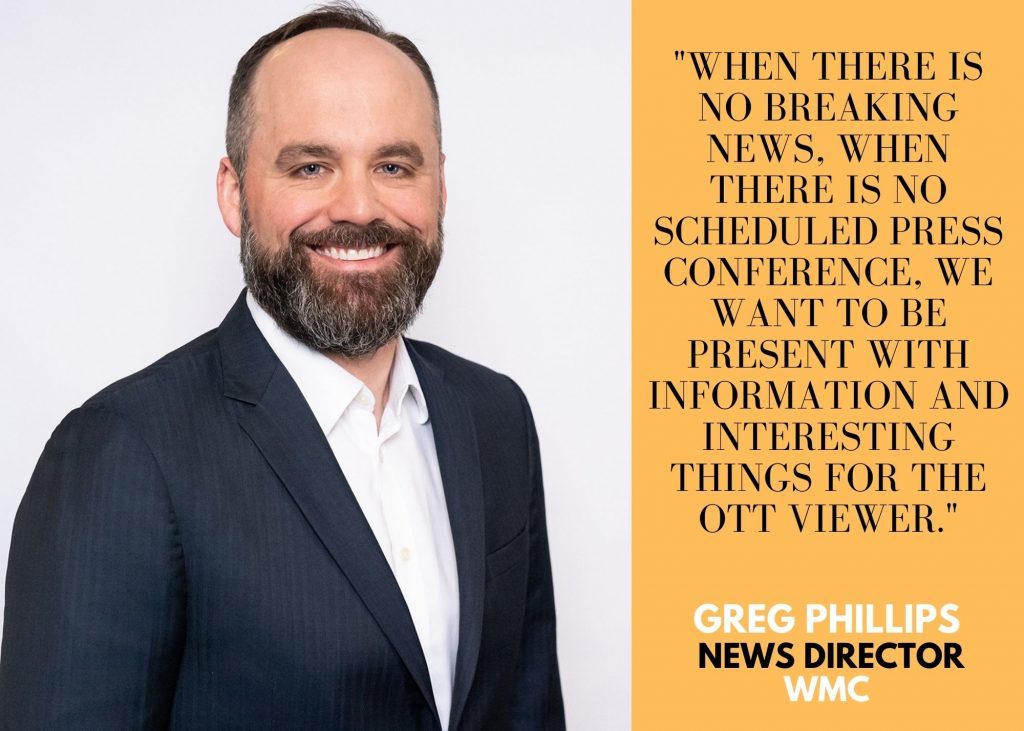
“We started seeing all these opportunities to literally program a new network. The light bulb just came on for all of us,” says Jonathan Mitchell, general manager of Gray’s Memphis station WMC.
Mitchell’s team didn’t let that light bulb moment go to waste. Next week, WMC is expected to launch (very softly — shhh!) a new digital channel called WMC Plus — or in effect two digital channels. A linear version will be broadcast over the air (OTA) while an on-demand version streams on the station’s OTT app.
WMC Plus won’t officially kick off with a full slate of original programs until September, but the project is already a model of collaboration and innovation that balances technical challenges, creativity and experimentation with careful planning and cost controls. Most of all, it’s homegrown. “It’s completely ours. It’s whatever we want to do. It’s the stuff that we can do really hyperlocal,” says Mitchell. “And it doesn’t really get much more local than local sports, local news and information.”

The idea started gathering steam last December, when the station began producing live University of Memphis sports events for ESPN Plus, with station personnel doing double duty to cover the games, on both sides of the camera. (Just one example: A young marketing producer turns out to be a talented sideline reporter too.). The station has produced about forty NCAA Division One games to date, in sports like men’s and women’s basketball, volleyball, men’s and women’s soccer, baseball, and softball. “And that kind of got the juices flowing,” Mitchell says. “What else can we do technologically to produce local programming? That we can’t put on WMC, but we can put on this digital channel.”
Sports executive producer Chris Olivere saw an opportunity to create “shoulder programming” around the events, even without rights to air the games themselves. “The question was, how do we leverage these live events and build content around that?” he says. “In this multi-screen world that we all live in now, we can do a pregame show on the new channel. And then for the fans who want to watch the games, we’ll be doing [them] live on ESPN Plus, and then they can come back to us on the WMC Plus channel for postgame.”

At the same time, news director Greg Phillips was developing new content ideas of his own. While he doesn’t call it shoulder programming, the concept is similar, in that it builds off what the station is already doing. Key to his plans: an innovation called the “digital desk” that allows a single anchor to become essentially a one-person studio operation, curating and creating content on the fly while adding production bells and whistles. Gray’s experiment with this “control room in a box” technology at Cleveland’s WOIO, which we told you about last year, was so successful, the company invested in digital desks throughout the group.
“It’s kind of like a one-person newscast,” Phillips says. “First and foremost is what’s happening now. It’s an opportunity to cover breaking news and, for lack of a better term, breaking information that’s going on in our community.” But the tool has also helped Phillips and his team produce extended interviews, anchor analysis, reporter’s notebooks, and even two COVID specials.

Phillips is so excited about the technology’s potential that he went to a single anchor format in his noon newscast to free up a person for the digital desk. He says the new channel is an opportunity to drill more deeply into his anchors’ interviewing and storytelling skills. “In the old days — the ‘old days,’ you know, two years ago — you had a live stream, you threw it out there and people watched it,” Phillips says. “Well now, it’s perspective: an anchor can watch it, give their thoughts, frame it with what has been leading up to this moment. What are the takeaways from it?”
Phillips has also made deals with local publications like the daily newspaper The Commercial Appeal, Memphis magazine, and an alternative weekly called Memphis Flyer, hoping to expand coverage of areas like food and music. “It’s an opportunity for them to showcase some of their work and reach an audience that they may be looking to reach. And it’s an opportunity for us to tap [into] their expertise and some of the cool work that they’re doing,” Phillips says. “All of these are rolled into creating content when there is nothing going on, if that makes sense. So when there is no breaking news, when there is no scheduled press conference, we want to be present with information and interesting things for the OTT viewer. So it’s a live experience, but it’s also a VOD experience.”

But those two “experiences” — OTA and OTT — pose a challenge: how do you monetize the content? “Well, that’s the tricky part,” says Jonathan Mitchell. “Because you’ve got two very different things: you’ve got a traditional linear broadcast channel, [and] you have an OTT channel that can sort of be all over the place.”
Part of the answer: With help from Gray digital guru Mike Braun, Mitchell has developed a system that allows the digital desk anchors to play back commercials without involving master control. He hopes to attract a new group of hyperlocal advertisers and sponsors. “We want this to be as local as possible,” he says. “It gives us the opportunity to give some advertisers a chance to reach their customers in a way that maybe they couldn’t on the WMC main channel. Their budget might be a little bit lower, but they really want to get out and begin advertising.”
But it will be a while before the sales team hits the bricks with the new offer. Mitchell and his team have been working out some technical glitches behind the scenes first. Hence the soft launch. “Let’s just get it up and running. Let’s make sure it’s good. And once it’s good, and we’re really programming it how we want to program it, then we can go out and start selling.”
So far, Mitchell has only added one “head” to the mix: a just-hired OTT producer will help Phillips and digital content manager Jessica Remer create new programming over the summer. And sports EP Chris Olivere will be looking for more deals with minor league and school teams, hoping to create “what would be a Mid-South version of a regional sports network, but it would be that on steroids.”
Can a new hyperlocal channel built on news and sports and distributed on linear and non-linear platforms work in other Gray markets? “First and foremost, it was an idea for Memphis, but we look at it as something that has a lot of tentacles, and it can really help some of our sister stations,” Mitchell says. “To me, it’s just a natural progression. If we can create it, and test it, and it works well, then we’ll want to show this to other stations and see if they want to follow the model.”
But for now, Mitchell and his team are busy trying to make their grassroots experiment in innovation a success in market #51, with corporate support but little interference. “I don’t care what size market you’re in,” Mitchell says. “You don’t have to be in a major market. You don’t have to be a network O-and-O. You can have a standard of excellence, and everyone can strive to reach that standard every single day.”
“It’s really whatever we make it,” Greg Phillips says. “That is the cool thing about it. We have the ability to forge our own path.”
Get the Lab Report: The most important stories delivered to your inbox